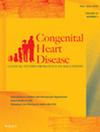COVID-19时代成人先天性心脏病患者:一年三级中心经验
IF 1.2
4区 医学
Q4 CARDIAC & CARDIOVASCULAR SYSTEMS
引用次数: 0
摘要
背景:成年先天性心脏病(ACHD)患者可能是冠状病毒病-2019 (COVID-19)的高危人群。本研究旨在报告为期一年的三级中心关于ACHD患者COVID-19感染的经验。方法:这是一项为期一年(2020年3月至2021年3月)的三中心回顾性研究,纳入了所有ACHD患者,报告了COVID-19阳性患者的医疗记录和管理情况。结果:542例患者中,新冠病毒阳性205例(37.8%),阴性337例(62.2%)。缓解的单心室和艾森曼格综合征患者更易感染COVID-19 (P < 0.05*)。心血管并发症为心律失常47例(22.9%),心力衰竭39例(19.0%),紫绀12例(5.9%),脑卒中/TIA 5例(2.4%),高血压合并感染性心内膜炎2例(1.0%),肺动脉高压合并肺栓塞1例(0.5%)。家中隔离11例(5.4%),抗生素147例(71.7%),重症监护病房(ICU) 32例(15.6%),肌力药物8例(3.9%),机械通气7例(3.4%),体外膜氧合2例(1.0%)。所有46例(22.4%)住院患者均给予血栓预防治疗。美国心脏病学会/美国心脏协会分类显示,复杂病变和FC-C/D类别更容易出现严重/危重症状,需要机械通气和ECMO (P < 0.05*)。3例(0.6%)患者报告死亡率,组间差异无统计学意义(P = 0.872)。接种疫苗193例(35.6%)。结论:ACHD患者COVID-19感染需要个体化风险分层和管理。艾森曼格综合征、单脑室姑息、复杂病变和FC-C/D患者更容易出现严重/危重症状,需要住院ICU、机械通气和ECMO。疫苗基本上是可以忍受的。本文章由计算机程序翻译,如有差异,请以英文原文为准。
Adults with Congenital Heart Disease during the COVID-19 Era: One-Year Tertiary Center Experience
Background: Adult patients with congenital heart disease (ACHD) might be at high risk of Coronavirus disease-2019 (COVID-19). This study aimed to report on a one-year tertiary center experience regards COVID-19 infection in ACHD patients. Methods: This is a one-year (March-2020 to March-2021) tertiary-center retrospective study that enrolled all ACHD patients;COVID-19 positive patients’ medical records, and management were reported. Results: We recorded 542 patients, 205 (37.8%) COVID-19-positive, and 337 (62.2%) COVID-19-negative patients. Palliated single ventricle and Eisenmenger syndrome patients were more vulnerable to COVID-19 infection (P < 0.05*). Cardiovascular COVID-19 complications were arrhythmias in 47 (22.9%) patients, heart failure in 39 (19.0%) patients, cyanosis in 12 (5.9%) patients, stroke/TIA in 5 (2.4%) patients, hypertension and infective endo-carditis in 2 (1.0%) patients for each, pulmonary hypertension and pulmonary embolism in 1 (0.5%) patient for each. 11 (5.4%) patients were managed with home isolation, 147 (71.7%) patients required antibiotics, 32 (15.6%) patients required intensive care unit (ICU), 8 (3.9%) patients required inotropes, 7 (3.4%) patients required mechanical ventilation, and 2 (1.0%) patients required extracorporeal membrane oxygenation (ECMO). Thromboprophylaxis was given to all 46 (22.4%) hospitalized patients. American College of Cardiology/American Heart Association classification revealed that complex lesions, and FC-C/D categories were more likely to develop severe/critical symptoms, that required mechanical ventilation and ECMO (P < 0.05*). Mortality was reported in 3 (0.6%) patients with no difference between groups (P = 0.872). 193 (35.6%) patients were vaccinated. Conclusions: COVID-19 infection in ACHD patients require individualized risk stratification and management. Eisenmenger syndrome, single ventricle palliation, complex lesions, and FC-C/D patients were more vulnerable to severe/critical symptoms that required ICU admission, mechanical ventilation, and ECMO. The vaccine was mostly tolerable.
求助全文
通过发布文献求助,成功后即可免费获取论文全文。
去求助
来源期刊

Congenital Heart Disease
CARDIAC & CARDIOVASCULAR SYSTEMS-
CiteScore
0.40
自引率
33.30%
发文量
37
审稿时长
6-12 weeks
期刊介绍:
Congenital Heart Disease is an open-access journal focusing on congenital heart disease in children and adults. Though the number of infants born with heart disease each year is relatively small (approximately 1% of the population), advances in treating such malformations have led to increased life spans for this population. Consequently, today most patients treated for congenital heart disease are over the age of 20. What are the special needs of adults with congenital heart disease? What are the latest developments in the care of the fetus, infants, and children? Who should treat these patients? How should they be treated?
Congenital Heart Disease focuses on these questions and more. Conceived as a forum for the most up-to-date information on congenital heart disease, the journal is led by Editor-in-Chief Vladimiro L. Vida, MD, Ph.D., Professor in Cardiac Surgery, University of Padua in Italy, as well as an international editorial board. Congenital Heart Disease publishes articles on heart disease as it relates to the following areas:
• Basic research of congenital heart disease
• Clinical pediatric and adult cardiology
• Cardiac imaging
• Preventive cardiology
• Diagnostic and interventional cardiac catheterization
• Electrophysiology
• Surgery
• Long-term follow-up, particularly as it relates to older children and adult congenital heart disease
• Exercise and exercise physiology in the congenital patient
• Post-op and critical care
• Common disorders such as syncope, chest pain, murmurs, as well as acquired disorders such as Kawasaki syndrome
The journal includes clinical studies, invited editorials, state-of-the-art reviews, case reports, articles focusing on the history and development of congenital heart disease, and CME material. Occasional issues focus on special topics.
Readership: Congenital Heart Disease was created for pediatric cardiologists; adult cardiologists who care for patients with congenital heart disease; pediatric and pediatric cardiology nurses; surgeons; radiologists; anesthesiologists; critical care physicians and nurses; and adult support staff involved in the care of patients with congenital heart disease.
 求助内容:
求助内容: 应助结果提醒方式:
应助结果提醒方式:


